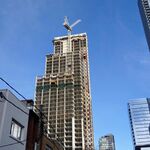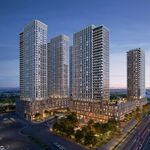R
rdaner
Guest
THE PERFECT HOUSE
A city of tall, aging buildings
JOHN BENTLEY MAYS
From Friday's Globe and Mail
Everyone who lives in Toronto is aware, in a general way, that our town has a lot of elderly high-rises. Nor are these survivors from the 1950s and 1960s merely, or mostly, concentrated in the old city centre. Hundreds of old apartment slabs and towers stand, in clusters or alone, along most important streets throughout the huge area embraced by Toronto's new city limits, from Etobicoke to Scarborough, from Front Street up to Steeles Avenue.
We tend to take these buildings for granted, I think, and most of us certainly don't spend time thinking about them.
One person who has given a great deal of fruitful, eye-opening thought to our stock of tall buildings is Graeme Stewart, who is currently at the end of his professional education at the University of Toronto's architecture school, and is also an employee of the well-known Toronto heritage-fabric firm E.R.A. Architects.
In the course of his exciting (if so far unpublished) research — which I came across almost by accident — Mr. Stewart has probed the reasons behind Toronto's widespread scattering of tall buildings, which, in other cities tend to be concentrated in the traditional downtown.
He has mapped the thinking of the official planners of Toronto during the post-war years, who thought the city would be best served by a widespread distribution of towers. Result: a city with a profile markedly different from most other North American urban concentrations, with their tall centres and broad skirts of low-density sprawl stretching out toward the horizon.
Another interesting (and surprising) fact Mr. Stewart has dug up has to do with the quantity of tall buildings. With some 2,000 towers of all kinds in the city and its suburbs, Toronto is second in North America only to New York in its population of high-rises, and far ahead of Chicago and Los Angeles, which are, of course, much larger cities.
In the 1960s, even as former corn fields in North York were sprouting thousands of bungalows, high-rises were also being put up at a remarkable rate. All this fervent activity prompted the visionary architect R. Buckminster Fuller to remark in 1968: “In Toronto, an unusually large number of high-rise apartments poke above the flat landscape many miles from downtown. ... [T]his is a type of high-density suburban development far more progressive and able to deal with the future than the endless sprawl of the U.S.â€
So much, says Mr. Stewart, for the “city of neighbourhoods.†Toronto is in fact a city of suburban tall buildings, and, despite the efforts of City Hall reformers to stem the tide, the current explosion of residential towers across Toronto is only the latest manifestation of this basic identity.
While Mr. Stewart's study is a contribution to the history and theory of Toronto's unique urbanism, it also has a quite practical side. The tall buildings thrown up during the city's post-war housing boom are getting old. What's to be done with them?
“The high-density nodes speckled through the region are great opportunities, an incredible asset,†he told me. “If we could retrofit them for higher environmental standards and mixed use development, right off the bat we could transform these currently neglected areas into socially sustainable neighbourhoods. It could be real, thriving community, no matter how little money people made.â€
Over the past few years, Mr. Stewart has been travelling extensively in Europe, especially in Russia and the former Soviet satellites, to learn what's being done there to revive and renew old apartment buildings. Like Toronto's residential high-rises, many Soviet-era blocks were built on large swathes of empty land. In the recent past, however, “kiosks have appeared at the bases of these buildings, transforming dead zones into lively markets.†The formerly isolated towers are being knit back into the urban fabric by means of retail and service outlets, libraries, schools, cinemas, restaurants — all being built on what was once just so much desolate lawn.
Back in Toronto, there's a great deal that can be done on the public policy front. “The city has leverage, the power to encourage redevelopment of old high-rise properties — insulating balconies and skins, integrating the buildings into new forms of commerce at their base, creating shopping, linking towers to neighbourhood amenities. It's not new technologies that are needed. A lot can be done with available technology.â€
One thing that should be discarded is the official planning ideology that treasures Toronto's patchwork of a few valuable neighbourhood “fiefdoms†— mostly urban fabric built up before the Second World War, such as the Annex and Cabbagetown — but has little love for the post-war suburban zones in which most Torontonians actually live. “We need a new spirit that does not see retrofitting as a detriment, but as a clever reuse of aging modern buildings we already have.â€
jmays@globeandmail.com
EDIT: Removed some formatting errors.
A city of tall, aging buildings
JOHN BENTLEY MAYS
From Friday's Globe and Mail
Everyone who lives in Toronto is aware, in a general way, that our town has a lot of elderly high-rises. Nor are these survivors from the 1950s and 1960s merely, or mostly, concentrated in the old city centre. Hundreds of old apartment slabs and towers stand, in clusters or alone, along most important streets throughout the huge area embraced by Toronto's new city limits, from Etobicoke to Scarborough, from Front Street up to Steeles Avenue.
We tend to take these buildings for granted, I think, and most of us certainly don't spend time thinking about them.
One person who has given a great deal of fruitful, eye-opening thought to our stock of tall buildings is Graeme Stewart, who is currently at the end of his professional education at the University of Toronto's architecture school, and is also an employee of the well-known Toronto heritage-fabric firm E.R.A. Architects.
In the course of his exciting (if so far unpublished) research — which I came across almost by accident — Mr. Stewart has probed the reasons behind Toronto's widespread scattering of tall buildings, which, in other cities tend to be concentrated in the traditional downtown.
He has mapped the thinking of the official planners of Toronto during the post-war years, who thought the city would be best served by a widespread distribution of towers. Result: a city with a profile markedly different from most other North American urban concentrations, with their tall centres and broad skirts of low-density sprawl stretching out toward the horizon.
Another interesting (and surprising) fact Mr. Stewart has dug up has to do with the quantity of tall buildings. With some 2,000 towers of all kinds in the city and its suburbs, Toronto is second in North America only to New York in its population of high-rises, and far ahead of Chicago and Los Angeles, which are, of course, much larger cities.
In the 1960s, even as former corn fields in North York were sprouting thousands of bungalows, high-rises were also being put up at a remarkable rate. All this fervent activity prompted the visionary architect R. Buckminster Fuller to remark in 1968: “In Toronto, an unusually large number of high-rise apartments poke above the flat landscape many miles from downtown. ... [T]his is a type of high-density suburban development far more progressive and able to deal with the future than the endless sprawl of the U.S.â€
So much, says Mr. Stewart, for the “city of neighbourhoods.†Toronto is in fact a city of suburban tall buildings, and, despite the efforts of City Hall reformers to stem the tide, the current explosion of residential towers across Toronto is only the latest manifestation of this basic identity.
While Mr. Stewart's study is a contribution to the history and theory of Toronto's unique urbanism, it also has a quite practical side. The tall buildings thrown up during the city's post-war housing boom are getting old. What's to be done with them?
“The high-density nodes speckled through the region are great opportunities, an incredible asset,†he told me. “If we could retrofit them for higher environmental standards and mixed use development, right off the bat we could transform these currently neglected areas into socially sustainable neighbourhoods. It could be real, thriving community, no matter how little money people made.â€
Over the past few years, Mr. Stewart has been travelling extensively in Europe, especially in Russia and the former Soviet satellites, to learn what's being done there to revive and renew old apartment buildings. Like Toronto's residential high-rises, many Soviet-era blocks were built on large swathes of empty land. In the recent past, however, “kiosks have appeared at the bases of these buildings, transforming dead zones into lively markets.†The formerly isolated towers are being knit back into the urban fabric by means of retail and service outlets, libraries, schools, cinemas, restaurants — all being built on what was once just so much desolate lawn.
Back in Toronto, there's a great deal that can be done on the public policy front. “The city has leverage, the power to encourage redevelopment of old high-rise properties — insulating balconies and skins, integrating the buildings into new forms of commerce at their base, creating shopping, linking towers to neighbourhood amenities. It's not new technologies that are needed. A lot can be done with available technology.â€
One thing that should be discarded is the official planning ideology that treasures Toronto's patchwork of a few valuable neighbourhood “fiefdoms†— mostly urban fabric built up before the Second World War, such as the Annex and Cabbagetown — but has little love for the post-war suburban zones in which most Torontonians actually live. “We need a new spirit that does not see retrofitting as a detriment, but as a clever reuse of aging modern buildings we already have.â€
jmays@globeandmail.com
EDIT: Removed some formatting errors.




